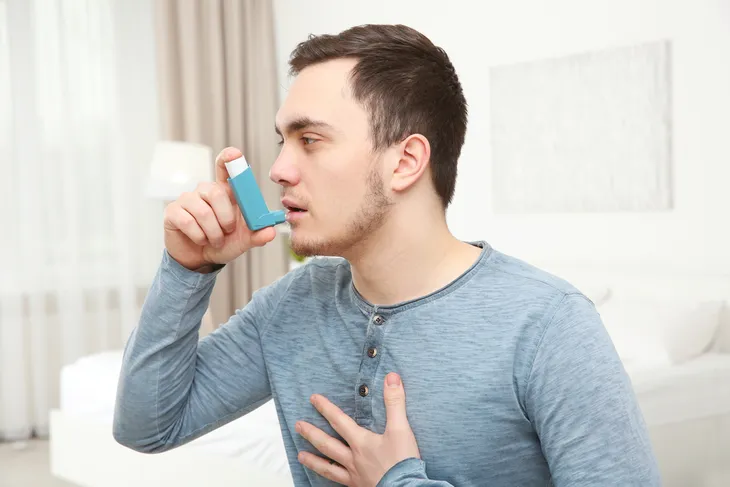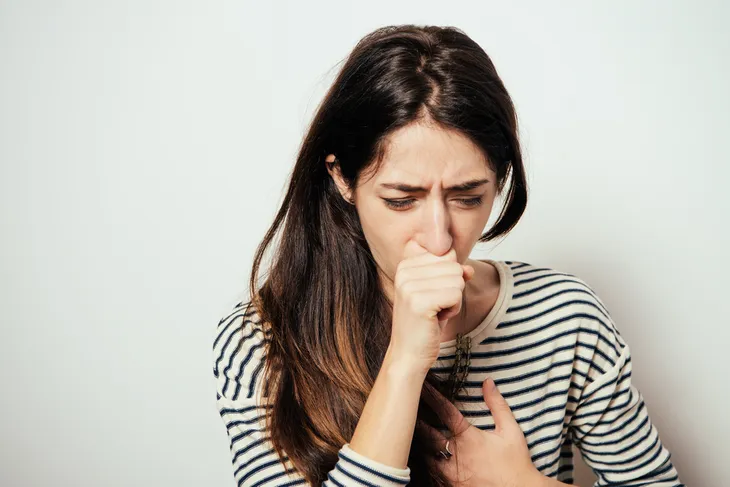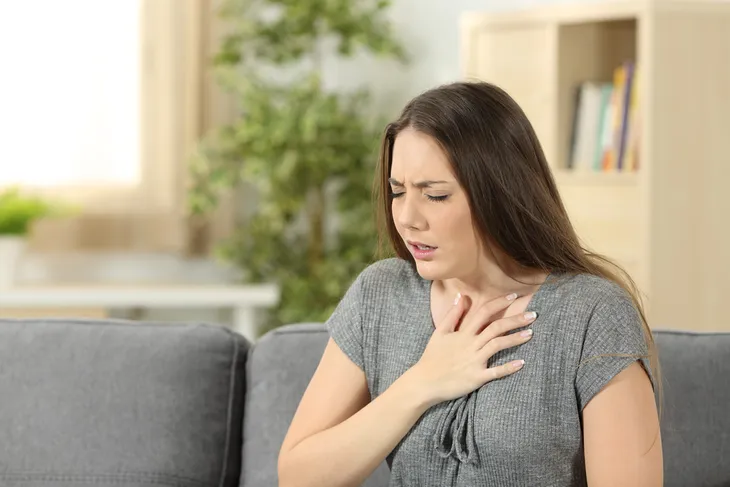There are a variety of lung diseases, and they can all present with early symptoms that could prompt a visit to your doctor, which could help you catch it in its early stages. The American Lung Association notes many people assume their cough or shortness of breath is part of normal aging, but that’s not always the case – it could be something more sinister.
Lung diseases can vary in severity but they should all be taken seriously. They include asthma, chronic obstructive pulmonary disease (COPD), and lung cancer, notes the association. However, even if you have these telltale symptoms, try to breathe easy until you see your physician for a proper diagnosis.
Shortness of Breath
Sure, it’s pretty normal to experience shortness of breath (clinically referred to as “dyspnea”) during and shortly after strenuous activities, such as jogging, heavy lifting, or climbing seven flights of stairs. However, the American Lung Association reminds you, “It’s not normal to experience shortness of breath that doesn’t go away after exercising.”
In some cases, you may find yourself trying to catch your breath even when you’ve been idle or have engaged in some light activity. If you have shortness of breath, it could be an early warning sign of a health issue related to your lungs.
Excessive Mucus Production
LiveStrong says having more mucus than normal could point to some lung diseases – namely asthma. This problem is common in America, and is characterized by wheezing and chronic inflammation of the airways (which can usually be controlled by a prescription inhaler).
Asthma also means increased production of mucus by the cells in the airways, which can further narrow air passages that have already shrunk due to inflammation. Acute bronchitis, another form of inflammation of the airways is often a complication of a viral illness, such as a cold, and can also lead to increased mucus production. Chronic bronchitis is one or two forms of COPD and also presents with increased mucus production, mostly in smokers and less often those exposed to secondhand smoke.
Chronic Chest Pain
WebMD has a long list of reasons you may be experiencing chest pain, but it says it can be traced to lung problems in some cases. One of these lung conditions is called pleuritis (or pleurisy), which the source says is inflammation of the lining of the lungs and chest that can cause sharp pain, especially when you breathe in (inhale) or cough.
Meanwhile, pneumonia is another common cause of chest pain, and it can come on suddenly with a host of symptoms, including high fevers, chills, fatigue, and cough (which may or may not be productive of mucus that can be green, yellow, or blood-streaked), notes the source. Pneumonia can be very serious (i.e., life threatening), so don’t ignore these symptoms.
Persistent Cough
Coughing due to a cold can last a while (anywhere from 2 to 4 weeks), but if you find that coughing has become persistent (or chronic), it might be time to see a doctor to find out why.
Smoking can cause some people to cough regularly, but even if you do smoke, you shouldn’t ignore this symptom, warns the Huffington Post. Chronic cough can be due to a number of health problems, including allergies, asthma, and acid reflux (most commonly).
Coughing Up Blood
This condition (known medically as hemoptysis) can be very alarming for a person, and it usually indicates there’s a health problem, explains LungCancer.org. As the name of the website suggests, it can be a symptom of lung cancer in particular.
The blood can appear on its own when you’re coughing, or it can be mixed in with mucus during a coughing fit, adds the source. Coughing up blood can also be associated with bronchitis. Either way, make sure you get yourself to a doctor pronto if you are experiencing this symptom.
Wheezing
The Mayo Clinic says if you’re wheezing when you’re breathing (as you might’ve guessed, this isn’t normal) it’s likely due to asthma and COPD, both of which narrow your airways.
Bronchitis is another possible cause of wheezing. However, this doesn’t always mean you have a lung disease, as other possible causes of wheezing include allergies and certain medications (particularly aspirin), adds the clinic. Wheezing at night could also be related to sleep apnea.
Voice Changes
Your first instinct when your voice changes might be that you’re suffering from a sore throat or some other viral illness, and while this might be the case, it could also be a warning sign of lung disease. If the hoarseness lasts longer than a couple of weeks, it should probably get checked out.
Reader’s Digest refers to an Egyptian study that explains “because people with COPD can’t hold as much air in their lungs, they could experience changes in their voice or have trouble getting the words out.”
Swelling in One Leg
You wouldn’t think that the lungs have anything to do with what’s happening in the legs, but all of our body parts are connected. So, when one organ or system is failing, it can cause strange symptoms elsewhere in the body. Swelling in the legs can occur due to a blood clot, also known as deep vein thrombosis, says Andrea McKee, MD, Chairman of Radiation Oncology at the Sophia Gordon Cancer Center at the Lahey Hospital & Medical Center in Burlington, Massachusetts, when talking to Reader’s Digest.
Blood clots anywhere in the body pose a serious risk because they can break off and float into more dangerous areas of the body like the lungs, heart, or brain. A blood clot in the lungs is called a pulmonary embolism, and it has the potential to block blood flow to the lungs, which can have some serious implications (even death). According to reports by the National Heart, Lung, and Blood Institute, 30-percent of patients who suffer from a pulmonary embolism die.
As a result, this condition requires immediate medical attention.
Fingernails are Blue
When our fingers or lips turn blue, it means there is something wrong with our blood circulation. Blue fingernails are a common symptom of lung disease, particularly in people with COPD because their tissues are not getting enough oxygen. This condition is known clinically as cyanosis.
Reader’s Digest warns people should pay close attention for any changes in their lips, fingernails and/or skin, because it could be due to cyanosis. This condition will cause these body parts to turn blue, gray, or even purple due to a lack of oxygen in their blood. “The color change might start off subtle and get progressively more noticeable as the disease progresses, or it might appear suddenly during an acute COPD attack,” writes the source.
If you notice any of these changes, consult with a doctor immediately.
Shoulder Pain
You might be experiencing some shoulder pain after a tough workout at the gym or roughing it up on the field during a sports game, and it’s probably due to inflammation or a strained muscle. But shoulder pain that comes on without any explanation is worrisome. If this is the case, you should consult with a doctor.
Reader’s Digest warns that shoulder pain can be a sign of lung cancer, particularly for people who smoke. “Certain types of lung tumors can pinch the nerves that supply the shoulders, which is why some of the earliest symptoms of lung disease can include pain in the shoulders,” writes the source.
Weight Loss
A lot of us spend a good portion of our time focusing on trying to shed a few pounds or at least maintaining our weight. However when the numbers on the scale begin dropping rapidly without any reasonable explanation, it’s not a good sign.
Weight loss is one of the common symptoms of COPD. In fact, Reader’s Digest states that 40 to 70-percent of patients with COPD experience this symptom. “Those dropped pounds are a sign that the body isn’t able to work efficiently. Your body is constantly burning calories just to do basic functions like breathing, but the muscles of people with COPD need to work harder to keep up with the body’s demands, burning about ten times more calories to breathe than people without lung disease,” writes the source.
In addition to COPD, Healthline points out that an extreme dip in weight can be due to lung cancer or many other types of cancer. Cancer causes weight loss because the cancer cells are using up energy in the body. “It could also result from shifts in the way the body uses energy from food,” says Healthline.
Just like many of the other symptoms on this list, weight loss alone isn’t a sign that you’re suffering from lung disease. However, if it accompanies many of the other symptoms on this list, it might be worth a visit to your doctor to get checked out.
Extreme Fatigue
We all struggle with feeling tired every now and again, but the fatigue associated with lung disease can’t be fixed with a few cups of coffee or a nap. The Lung Cancer Alliance points out that lung cancer patients will struggle with fatigue because their lungs are not functioning properly, causing their bodies to work overtime.
The difficult thing with this symptom is that it’s a common symptom for several other serious (and not so serious) health conditions. So just because you’re feeling a little sluggish over a few days doesn’t mean it’s due to lung disease. The best thing to do is to assess whether it’s in addition to several other symptoms on this list and consult with a doctor to determine the cause.
No Symptoms
There is nothing more scary than a serious health condition that comes with no warning signs or symptoms. Reader’s Digest talked to Andrea McKee, MD, who warns that early stage lung cancer typically presents no symptoms at all. “We usually find stage 1 lung cancer by accident,” usually during a chest or spine X-ray for another unrelated issue.
If a patient has lung cancer and is experiencing symptoms elsewhere in the body, it typically means the cancer has spread elsewhere in the body (a condition referred to as metastasis). People who are at a high risk for lung cancer (i.e., over the age of 55 and with a 30-plus pack-year history of smoking), should be screened with a low-dose CT scan, suggests the source. “That’s nine million people,” adds McKee.
















